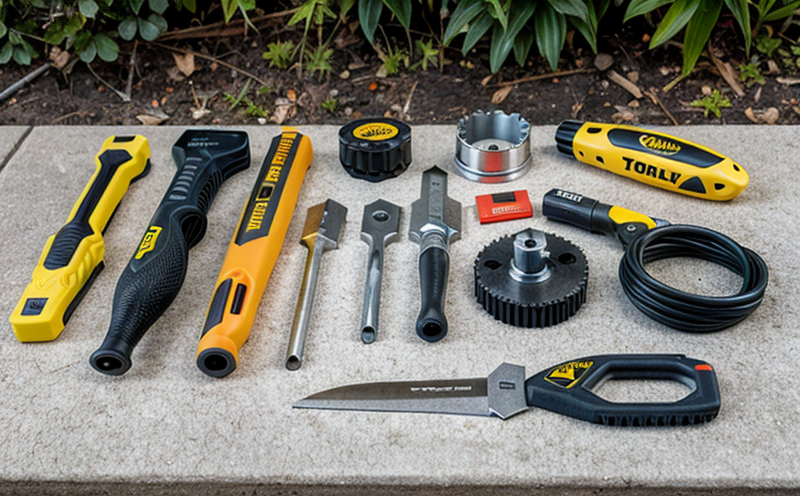Dust Emission Testing of DIY Tools
In today's do-it-yourself (DIY) culture, safety remains a paramount concern. Dust emissions from DIY tools can pose significant health risks to users and those in proximity. This service provides comprehensive testing for dust emission levels from various DIY hand tools, ensuring compliance with relevant standards and safeguarding end-users.
Dust emissions from DIY tools are particularly concerning due to the small particle sizes involved which can easily be inhaled by operators or bystanders. These particles may contain harmful substances that could lead to respiratory issues over time. Therefore, it is critical for manufacturers of DIY tools to ensure their products meet stringent dust emission standards.
Our laboratory uses advanced analytical techniques such as gravimetric analysis and optical particle sizers (OPS) to measure the amount of airborne particulate matter generated during typical usage conditions. These methods allow us to quantify both total dust emissions and particle size distribution, providing a complete picture of potential health hazards associated with each tool.
The testing process involves simulating real-world operating scenarios under controlled laboratory settings. We carefully prepare samples by exposing them to various pressures and speeds that mimic actual use cases. This ensures accurate measurement of dust released into the air during normal operation.
Once collected, samples are analyzed using state-of-the-art equipment capable of detecting even trace levels of particulate matter. Our analysts then compare results against specified limits outlined in international standards like ISO 14086-2:2007 and EN 13790:2017 which specify acceptable thresholds for residential exhaust air quality.
Results from these tests play a crucial role in helping manufacturers identify problem areas within their product designs early on, allowing them to make necessary adjustments before releasing products onto the market. By adhering strictly to prescribed limits set forth by relevant bodies, companies demonstrate their commitment to maintaining high standards of occupational health and safety.
Compliance with these regulations not only protects consumers but also enhances brand reputation among environmentally conscious customers who value sustainable practices throughout product lifecycle stages. Furthermore, successful completion of such tests can open doors for international export opportunities where stringent regulatory requirements apply.
In summary, dust emission testing serves as an essential tool in identifying potential risks associated with DIY hand tools and ensuring they meet industry best practices. Through rigorous analysis conducted by experienced professionals using cutting-edge technology, we provide reliable data that guides continuous improvement efforts aimed at enhancing overall product quality and safety.
Why It Matters
The importance of dust emission testing cannot be overstated when considering the impact on user health and well-being. Exposure to high levels of airborne particulate matter has been linked to various respiratory conditions such as asthma, bronchitis, and even lung cancer. For DIY enthusiasts who frequently use power tools or hand-held devices like sanders, routers, drills etc., regular testing helps identify any latent issues early on.
From a regulatory perspective, meeting specified limits ensures compliance with local laws governing industrial hygiene and occupational health. This not only minimizes legal risks but also fosters trust between manufacturers and customers regarding product safety and reliability.
In addition to protecting end-users, rigorous testing contributes significantly towards reducing environmental pollution. By minimizing unnecessary dust release during operation, we contribute positively towards cleaner air quality both at home and within communities.
For companies operating in competitive markets where reputation plays a key role in maintaining customer loyalty, demonstrating commitment to safety through proactive measures like this can set them apart from competitors offering similar products.
Applied Standards
Dust emission testing is governed by several international standards designed specifically for residential exhaust air quality. Two prominent ones include:
- ISO 14086-2:2007 – This standard defines procedures and requirements for measuring the mass concentration of particulate matter in indoor environments. It provides guidelines on how to collect samples accurately while minimizing interference from external factors.
- EN 13790:2017 – Developed with input from experts across Europe, this document establishes harmonized methods for determining the average mass concentration of respirable dust particles (PM10) within enclosed spaces. Compliance ensures that emissions remain well below permissible limits set forth by local authorities.
Besides these globally recognized frameworks, many countries have their own specific regulations tailored to meet unique national needs. For instance:
- ASTM E2758-19 – American Society for Testing and Materials' standard practice provides detailed instructions on how to perform gravimetric analysis of respirable dust from construction equipment.
- IEC 60312 – International Electrotechnical Commission's guideline covers electrical insulation materials used in tool manufacturing, including those subjected to severe environmental conditions which can affect performance over time.
By adhering strictly to these guidelines during our testing procedures, we ensure that all findings are valid and reliable across different regions worldwide. This consistency helps manufacturers maintain consistent quality standards regardless of geographical location or market segment.
Quality and Reliability Assurance
At our laboratory, maintaining the highest levels of accuracy and precision is crucial for delivering trustworthy results that can be relied upon by industry stakeholders. To achieve this goal, we employ a multi-faceted approach involving:
- Calibration: All instruments used in testing are regularly calibrated against certified reference standards to ensure their operational integrity.
- Data Validation: Before final reports are generated, multiple checks are performed to verify data consistency and accuracy. This includes cross-referencing results with previous measurements whenever possible.
- Quality Control Measures: Our team adheres strictly to established quality control protocols throughout every stage of the testing process from sample preparation through analysis up until report generation.
- Continuous Improvement: Regular reviews are conducted based on feedback received from clients as well as ongoing advancements in analytical techniques. This ensures that our methods remain current and effective in addressing emerging challenges faced by DIY tool manufacturers today.
We understand that trust in our testing capabilities comes not only from the accuracy of results but also consistency over time. By implementing robust quality control measures, we strive to maintain a high level of reliability throughout all phases of dust emission testing.





